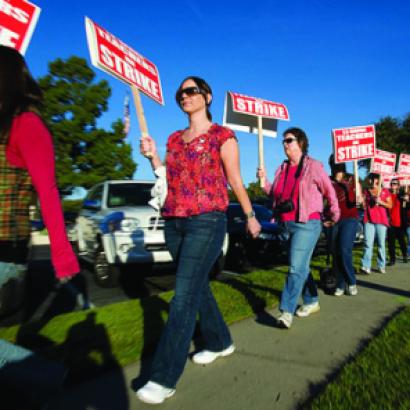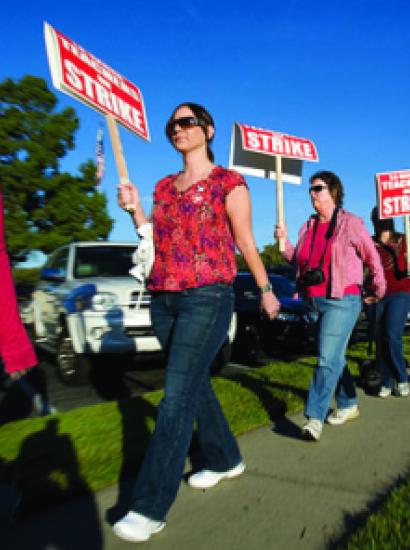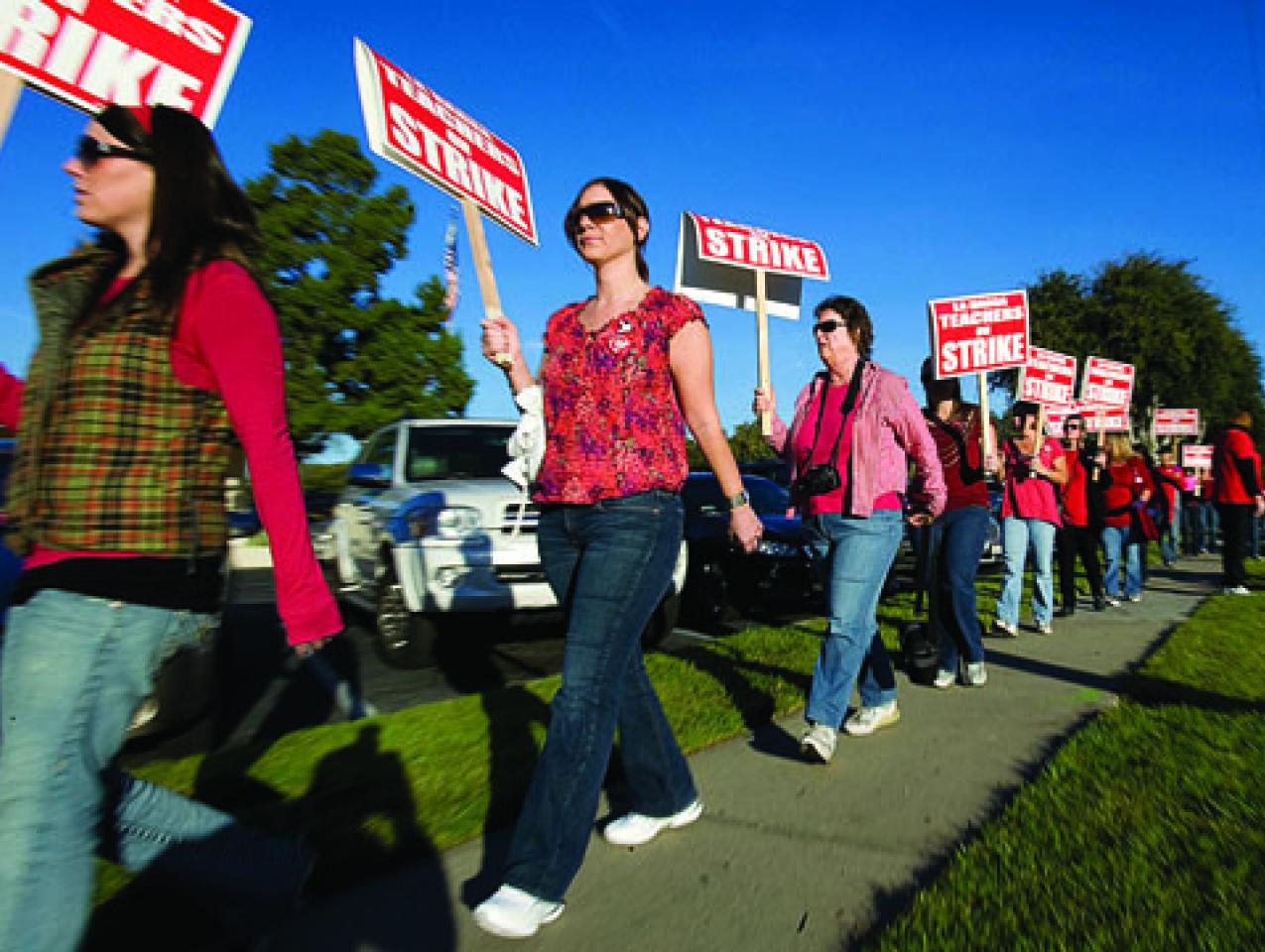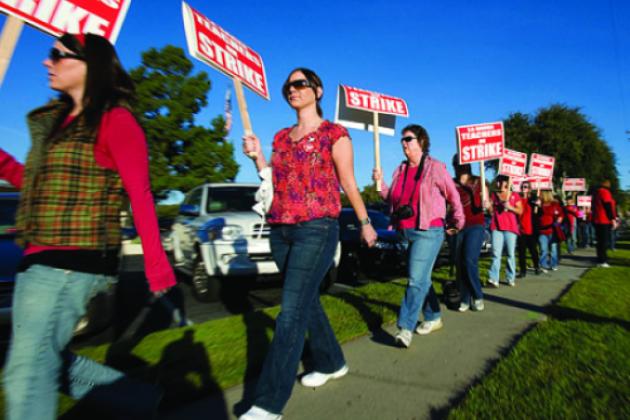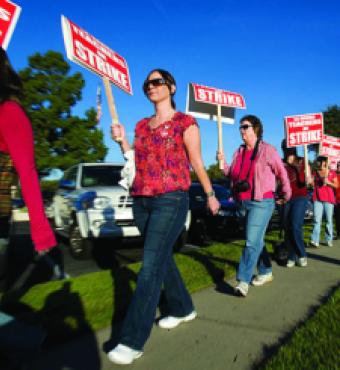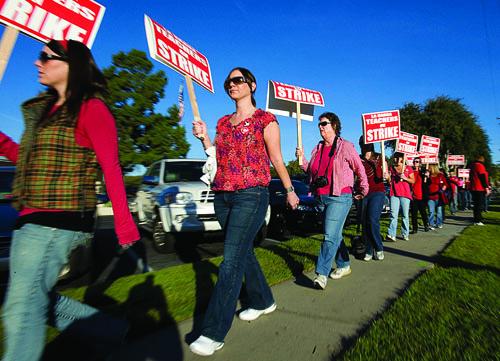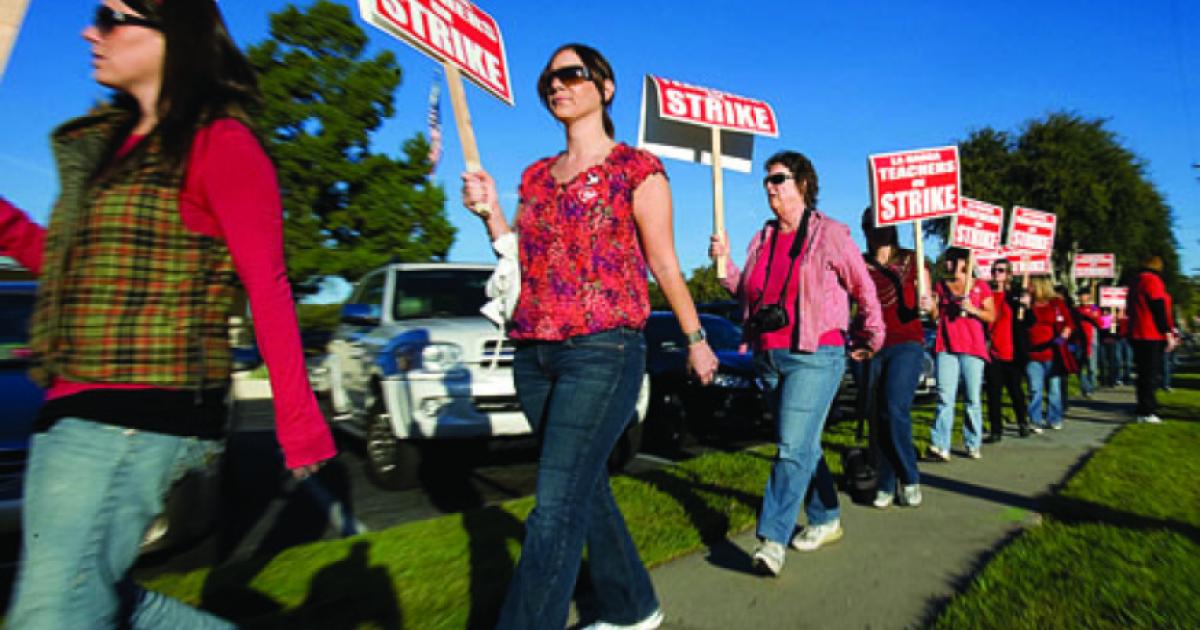- Law & Policy
- Regulation & Property Rights
- US Labor Market
- Budget & Spending
- Education
- K-12
- Campaigns & Elections
- State & Local
- Politics, Institutions, and Public Opinion
- Economics
Janet Archer painted watercolors. Gordon Russell planned trips to Alaska and Cape Cod. Others did crossword puzzles, read books, played chess, practiced ballet moves, argued with one another, and otherwise tried to fill up the time. The place was New York City. The year was 2009. And these were public school teachers passing a typical day in one of the city’s Rubber Rooms—Temporary Reassignment Centers—where teachers were housed when they were considered so unsuited to teaching that they needed to be kept out of the classroom, away from the city’s children.
There were more than seven hundred teachers in New York City’s Rubber Rooms that year. Each school day they went to “work.” They arrived in the morning at exactly the same hour as other city teachers, and they left at exactly the same hour in the afternoon. They got paid a full salary. They received full benefits, as well as all the usual vacation days, and they had their summers off. Just like real teachers. Except they didn’t teach.
All of this cost the city between $35 million and $65 million a year for salary and benefits alone, depending on who was doing the estimating. And the total costs were even greater, for the district hired substitutes to teach their classes, rented space for the Rubber Rooms, and forked out half a million dollars annually for security guards to keep the teachers safe (mainly from one another, as tensions ran high in these places). At a time when New York City was desperate for money to fund its schools, it was spending a fortune every year for seven-hundred-plus teachers to stare at the walls.
Mayor Michael Bloomberg and Chancellor Joel Klein wanted to move bad teachers out of the system and off the payroll. But they couldn’t. While most of their teachers were doing a good job in the classroom, the problem was that all teachers—even the incompetent and the dangerous—were protected by state tenure laws, by restrictive collective bargaining contracts, and by the local teachers’ union, the United Federation of Teachers (UFT), which was the power behind the laws and the contracts and the legal defender of each and every teacher whose job was in trouble.
With such a big defensive line, teachers who were merely mediocre could not be touched. So Bloomberg and Klein chose to remove just the more egregious cases and send them to Rubber Rooms. But even these teachers stayed on the payroll—for a long time. They didn’t leave; they didn’t give up; and because the legal procedures were so thickly woven and offered union lawyers so much to work with, it took from two to five years just to resolve the typical case.
THE DYSFUNCTIONAL IS NORMAL
Sometimes it seems that public education operates in a parallel universe, in which what is obviously perverse and debilitating for the organization of schools has become normal and expected. The purpose of the American public school system is to educate children. And because this is so, everything about the public schools—how they are staffed, how they are funded, and more generally how they are organized to do their work—should be decided with the best interests of children in mind. But this isn’t what happens. Not even remotely.
The New York City school district is not organized to provide the best possible education to its children. As things now stand, it can’t be. Why? If we could view the district’s entire organization, we would doubtless find many reasons. But when it comes to bad teachers alone, the district is wasting millions of dollars because the rules it is required to follow in operating the schools—rules that are embedded in the local collective bargaining contract and state law—prevent it from quickly, easily, and inexpensively removing these teachers from the classroom. Getting bad teachers out of the classroom is essential if kids are to be educated effectively. Yet the formal rules prevent it.
These rules are part of the organization of New York City’s schools. The district is literally organized to protect bad teachers and to undermine the efforts of leaders to ensure teacher quality. It is also organized to require that huge amounts of money be wasted on endless, unnecessary procedures. These undesirable outcomes do not happen by accident. They happen by design.
New York may seem unusual. Its dimensions dwarf those of the typical American school district, and its organizational perversities may be extreme as well. But the kind of problem I discuss here is quite common. Almost everywhere, in districts throughout the nation, America’s public schools are typically not organized to provide the nation’s children with the highest quality education.
One example: salary schedules that pay teachers based on their seniority and formal credits and have nothing whatever to do with whether their students are learning anything. Another example: rules that give senior teachers their choice of jobs and make it impossible for districts to allocate teachers where they can do the greatest good for kids. Another example: rules that require districts to lay off teachers (in times of reduced revenues or enrollments, say) in reverse order of seniority, thus ensuring that excellent teachers will be automatically fired if they happen to have little seniority and that lousy teachers will be automatically retained if they happen to have lots of seniority.
These sorts of rules are common. But who in their right mind, if they were organizing the schools for the benefit of children, would organize them in this way? No one would. Yet the schools do get organized in this way. The examples I’ve given are the tip of a very large iceberg. As a result, even the most obvious steps toward better education are difficult, if not impossible, to take.
Researchers have long known, for example, that when a student is fortunate enough to have a teacher near the high end of the quality distribution rather than a teacher near the low end, the impact amounts to an entire year’s worth of additional learning. Teacher quality makes an enormous difference. Indeed, even if the quality variation across teachers is less stark, the consequences for kids can still be profound. As researchers Eric Hanushek and Steven Rivkin report, if students had good teachers rather than merely average teachers for four or five years in a row, “the increased learning would be sufficient to close entirely the average gap between a typical low-income student receiving a free or reduced-price lunch and the average student who is not receiving free or reduced-price lunches.” In other words, it would eliminate the achievement gap that this nation has struggled to overcome for decades. Good teachers matter, and they matter a lot. Yet our school system is organized to make it virtually impossible to get bad teachers out of the classroom, bases key personnel decisions on seniority rather than expertise, and in countless other ways erects obstacles to providing children with the best possible teachers.
Ineffective organization has long been an open secret. A Nation at Risk warned in 1983 of a “rising tide of mediocrity” in America’s schools—leading to a frenzied era of nonstop reforms that, it was hoped, would bring dramatic improvement. But today the facts show that this dramatic improvement hasn’t happened, and that bold reforms are still needed to turn the schools around. The most intensive period of school reform in the nation’s history has largely been a failure. So we now have two questions to ponder. To the first, which asks why the public schools are burdened by ineffective organization, we can add a second: why has the reform movement, which for a quarter century has been dedicated to bringing effective organization to the nation’s schools, failed to do that? The answer to both questions, I argue, is much the same: these problems are largely due to the power of the teachers’ unions.
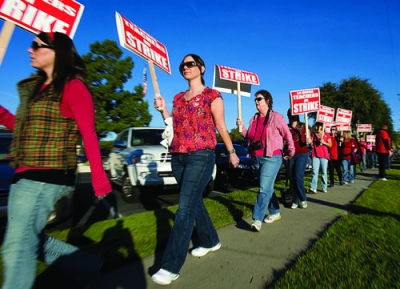
UNION POWER AND AMERICA’S SCHOOLS
It might seem that the teachers’ unions would play a limited role in public education: fighting for better pay and working conditions for their members, but otherwise having little impact on the structure and performance of the public schools more generally. Yet nothing could be further from the truth. The teachers’ unions have more influence on the public schools than any other group in American society.
Their influence takes two forms. They shape the schools from the bottom up, through collective bargaining activities so broad in scope that virtually every aspect of school organization bears the distinctive imprint of union design. They also shape the schools from the top down, through political activities that give them unrivaled influence over the laws and regulations imposed on public education by government, and that allow them to block or weaken governmental reforms they find threatening. In combining bottom-up and top-down influence, and in combining them as potently as they do, the teachers’ unions are unique among all actors in the educational arena.
It’s difficult to overstate how extensive a role the unions play in making America’s schools what they are—and in preventing them from being something different.
Before the 1960s, the power holders in America’s public school system were the administrative professionals charged with running it, as well as the local school boards who appointed them. Teachers had little power, and they were unorganized aside from their widespread membership in the National Education Association (NEA), which was a professional organization controlled by administrators. In the 1960s, however, states began to adopt laws that for the first time promoted collective bargaining for public employees. When the American Federation of Teachers (AFT) launched a campaign to organize the nation’s teachers into unions, the NEA turned itself into a labor union (and eventually kicked out the administrators) to compete, and the battle was on in thousands of school districts. By the time the dust settled in the early 1980s, virtually all districts of any size (outside the South) were successfully organized, collective bargaining was the norm, and the teachers’ unions reigned supreme as the most powerful force in American education.
This transformation—the rise of union power—created what was essentially a new system of public education. This new system has now been in equilibrium for roughly thirty years, and throughout this time it has been vigorously protected—and stabilized—by the very union power that created it.
POLITICAL WEAPONS AND HOW TO BLUNT THEM
The trademark of this new system is not just that the teachers’ unions are pre-eminently powerful. It is also that they use their power to promote their own special interests—and to make the organization of schooling a reflection of those interests. They say, of course, that what is good for teachers is good for kids. But the simple fact is that they are not in the business of representing kids. They are unions. They represent the job-related interests of their members, and these interests are not the same as the interests of children.
Some things are obvious. It is not good for children that ineffective teachers cannot be removed from the classroom. It is not good for children that teachers cannot be assigned to the classrooms where they are needed most. It is not good for children that excellent young teachers get laid off before mediocre colleagues with more seniority. Yet the unions fight to see that schools are organized in these ways.
And there’s more. The organization of schooling goes beyond the personnel rules of collective-bargaining contracts to include all the formal components of the school system: accountability, choice, funding, class size, special education, and virtually anything else policymakers deem relevant. These matters are subject to the authority of state and national governments, where they are fought out in the political process—and decisions are heavily determined by political power.
Here the unions’ great strength as political organizations comes into play. The NEA and the AFT, with more than four million members between them, are by far the most powerful groups in the politics of education. They wield astounding sums of money, year after year, for campaign contributions and lobbying. They have armies of well-educated activists in every political district. They can orchestrate well-financed public-relations and media campaigns any time they want, on any topic or candidate. And they have supremely well-developed organizational apparatuses that blanket the country.
They don’t always get their way on public policy, of course. The American system of checks and balances makes that impossible. But these same checks and balances also ensure that blocking new laws is much easier than getting them passed, and this is how the teachers’ unions have used their power to great effect: not by getting the policies they want, but by stopping or weakening the policies they don’t want—and thus preventing true education reform.
From the beginning of the reform era, reformers have focused on the problem of ineffective schools, and thus on fixing the schools themselves. Yet they have failed to resolve this problem because there is another problem—the problem of union power—that is more fundamental, and has prevented them from fixing the schools in ways that make sense and have real promise. If our nation ever hopes to transform the public schools, this problem of union power must be recognized for what it is. And it must be resolved.
But can it be resolved? This is the pivotal question for the future of American education. The answer, I believe, is yes—although major change may take decades.
In normal times, reformers who try to change the system or its underlying power structure will almost always lose. This is the Catch-22 of power: if you try to weaken powerful groups, they will normally be able to use their power to stop you. Yet, fortunately for the nation, these are not normal times. American education stands at what political scientists would call a critical juncture. Because of a largely accidental and quite abnormal confluence of events, the stars are lining up in a way that makes major change possible, and in fact will drive it forward. Two separate dynamics are at work.
The first is arising “endogenously”—that is, within the education system and its politics. More than at any other time in modern history, the teachers’ unions are on the defensive: blamed for obstructing reform, defending bad teachers, imposing seniority rules, and in general, using their power to promote their own interests rather than the interests of kids and effective organization. And open criticism is coming not just from conservatives anymore. It is also coming from liberals, moderates, and Democrats. Key constituencies have become fed up. Fed up with perpetually abysmal schools for disadvantaged kids. Fed up with the party’s perpetual impotence with regard to reform. Fed up with what Jonathan Alter of Newsweek has called the “stranglehold of the teachers’ unions on the Democratic Party.” The demand is palpable for the party to free itself to pursue serious education reform in the best interests of children, especially those who need it the most.
But the shifting political tides will not be enough to bring about major education reform. Absent some other dynamic, the unions will remain very powerful, with over four million members, tons of money, countless activists, and all their other weapons still intact. Their Democratic allies will allow reform to go only so far before pulling up short. Luckily, another dynamic is at work. This one is “exogenous”—arising entirely outside the educational and political systems—and will ultimately dovetail nicely with the political trends that are running against the unions. I’m speaking about the revolution in information technology, one of the most profoundly influential forces ever to hit this planet. It is fast transforming the fundamentals of human society, from how people communicate and interact to how they collect information, gain knowledge, and transact business. There is no doubt that it has the capacity to transform the way children learn, and that it will ultimately revolutionize education systems all around the world, including our own.
The specific kinds of changes wrought by technology—among them the massive substitution of technology for labor, the growing irrelevance of geography for teaching (which means that teachers can be anywhere, and no longer need to be concentrated in districts), and the huge expansion in attractive alternatives to the regular (unionized) public schools—are destined to undermine the very foundations of union power and make it much more difficult for them to block reform and impose their special interests through politics. This will lay the groundwork, over a period of decades, for truly massive reforms—and for the rise of a new system that is much more responsive to children’s needs and much better organized to provide the quality education they deserve.
LOOKING FOR A GAME-CHANGER
Although the teachers’ unions have tremendous influence over the nation’s schools, they have been very poorly studied—and as a result, very poorly understood. My book, Special Interest, attempts to change that by providing a great deal of information: on the unions’ historical rise to power, on how they use their power in politics and collective bargaining, and on what the consequences seem to be for effective schools. But it also, and more fundamentally, offers a way of understanding why the unions do what they do—and thus why they engage in behavior that so often creates problems for children and schools.
By way of introduction, let’s first consider the behavior of members of Congress. They are well known for crafting legislation to advance the special interests of favored constituents and powerful groups and companies. They lard their bills up with thousands of special-interest earmarks. They fill the tax code with special-interest deductions, credits, and loopholes. They support an archaic, inefficient system of farm subsidies. They even insist that the government buy expensive planes and weapons systems, produced in their states and districts, that the Defense Department says it does not want.
So here is the question. Why don’t members of Congress just stop doing these things and instead do what’s in the national interest? The answer is that they have strong incentives to do exactly what they are doing. The incentives, moreover, are not a matter of choice, but arise from the electoral and legislative institutions of which these members are a part. The fact is, if they want to stay in their jobs and succeed, they need to respond to these incentives—and cater to the special interests of constituents and powerful groups.
None of this has much to do with who they are as human beings, nor with what they value or how they behave in other realms of their lives. Any human beings who want to be members of Congress—and want to stay there—need to respond wisely and efficiently to the incentives of their institutions. If they don’t, they’ll be looking for other jobs.
The teachers’ unions can be understood in exactly the same way. Like members of Congress, union leaders are elected to their organizational roles, and in those roles—but not in the rest of their lives—they have strong incentives to behave in very distinctive ways. Above all else, they must be centrally concerned with pleasing their members—their constituents—who are employees of the public school system, and who fully expect their unions to protect their jobs, to get them higher wages and better benefits, to push for teacher-friendly work rules, to oppose threatening reforms, and in general, to fight for their basic job-related interests. Union leaders will be special-interest advocates for their members.
As human beings, union leaders may care very deeply about children and want the best for them. They may also be very concerned about the quality of education and be convinced that significant improvement in the public schools is called for. More generally, they may be very good, public-spirited people. But these qualities are not of the essence when it comes to what they do in their jobs. In that role, they have strong incentives to be special-interest advocates. And that is how they will behave.
In the private sector, the unions are transparent about their special-interest role. What’s to hide? The United Auto Workers pushes hard to secure good wages and benefits for employees on the auto assembly lines, and it doesn’t pretend to be concerned, first and foremost, with the welfare of the millions of consumers who buy cars. The teachers’ unions, however, are in the public sector, and there the institutional incentives are very different—for they need to depend heavily on the political process, and thus on gaining democratic support for what they do and want. To behave wisely in this setting, they have incentives to convince the voting public that they are not self-interested but in fact fundamentally concerned about children and quality education—and that whatever they do to promote their own interests is actually good for children and schools too.
There is often a big gulf, therefore, between what they say and what they do. When teachers’ unions argue, for example, that charter schools should be opposed because of their poor academic performance, they may or may not be saying something accurate about the actual performance of charter schools. The more important fact is that this is not why they oppose charter schools in the first place. They oppose them because charters give kids alternatives to the regular public schools—allowing them to leave, and thus threatening the jobs of unionized teachers. In politics, however, they can’t just say that. Instead, their job is to look around for other arguments—any arguments—that might persuade voters to support the unions’ predetermined position. The themes, accordingly, are all about what’s good for kids and schools. Their special interests are carefully hidden inside a public-interest package.
We need to keep the focus on the players’ incentives and interests. When we do that, we have a solid foundation for understanding the unions’ role within American education. Here is a summary of the basics:
- The teachers’ unions are special-interest groups.
- As the most powerful groups in American education, they use their power to promote these special interests—in collective bargaining, in politics—and this often leads them to do things that are not good for children or for schools.
- None of this has anything to do with union leaders or teachers being self-interested as human beings. The unions can be—and are—special-interest groups, even though leaders and teachers may well care very much about children, quality education, and effective schools.
Interest-group influence is hardly unusual in American politics and government. Indeed, it is the normal state of affairs across all areas of public policy. To say that public education is an arena of special-interest influence, then, is simply to say that it is normal. If education is at all different, it is only because one special interest is far more powerful than any others. By focusing on that one special interest, then, and by learning about the various roles it plays in shaping the public schools and the policies that govern them, we should be able to learn a great deal about the American education system—and why its serious problems have yet to be overcome despite a quarter century of national effort.








